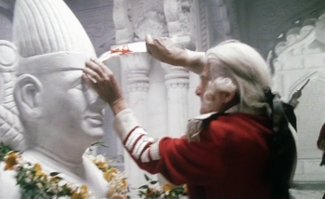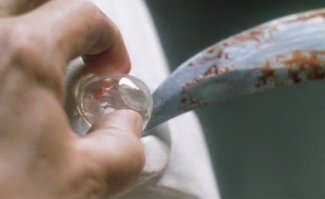The Moonstone
By M. Gowlett, guest author
When considering which period drama to pick out and watch, maybe the handsome face of Greg Wise (alias Willoughby of Sense and Sensibility) looking out at me from the DVD cover was a factor influencing my choice of the 1997 TV film The Moonstone. Whatever the reason, pick it out I did, and found it a fascinating and enjoyable watch, which inspired me to research a bit into it and write something about it.
I will start with a brief plot summary to put you in the picture. A precious Indian diamond called the Moonstone, acquired by dubious means, is bequeathed to a young lady Rachel Verinder by her uncle. It is delivered to her by her cousin Franklyn Blake, whom she hasn’t seen since their childhood (when he was an irritating little boy) and who has now returned from his travels in Europe as a good-looking eligible young man. They very easily fall in love with each other, but unfortunately, the romance is blighted by the diamond which turns out to carry a curse. Initially Rachel was so thrilled with her diamond that she insisted on wearing it on her birthday evening, when three suspect Indian jugglers appeared and took an unnatural interest in it. From there the story unfolds through a string of misfortunes, but we can at least rest assured, knowing from the opening scene that there is a happy ending.
For me, the film The Moonstone scored well in all the classic aspects required of a good period drama: good acting, great costumes, authentic and beautiful filming location, and good atmospherics providing the backdrop needed to bring period pieces to life. As filming location, the lovely country house Heydon Hall in Norfolk, built in 1581, provided the perfect setting and decor to accurately portray the lifestyle of well-to-do landed family living in England in the early to mid 19th century.
This 1997 BBC film version of The Moonstone is categorised by IMDb in the genres Crime, Mystery and Drama. There have been other versions of the film, including another TV series in 1972, and a feature film made in 1934 in which the mystery element was very much stronger than in this version. Incidentally (and irrelevantly) the lead male role of Franklyn Blake played by Greg Wise in the 1997 version, was played in the 1934 film by the Nova Scotia-born actor David Manners (nee Rauff de Ryther Daun Acklom) who, on his mother’s side, was distantly related to Princess Diana.
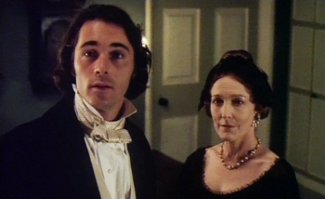
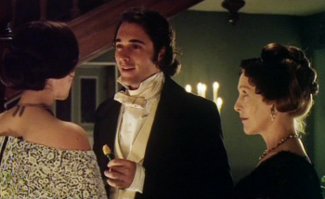
Top: Franklyn Blake (Greg Wise) and Lady Julia Verinder (Patricia Hodge). The moment Franklyn sees Rachel for the first time since their childhood. Bottom: Rachel Verinder (Keeley Hawes), Franklyn Blake (Greg Wise) and Lady Julia Verinder (Patricia Hodge).
What is special about The Moonstone is that it is based on a book that is reputed to be the very first detective novel, which makes the book and the film quite unique. The book, The Moonstone, was written by Wilkie Collins who was a good friend of England’s most famous novelist, Charles Dickens. Collins had published stories in Dickens’ journals prior to publishing The Moonstone in 1868, just 2 years before the death of his dear friend Dickens. The book belonged to Mystery and Sensation fiction (in the 1860s a popular genre with ‘Gothic’ connotations) incorporating scary/spooky/exotic aspects in the domestic setting of a country or London house, featuring such things as laundry lists as key to the plot. However The Moonstone also had this brand new detective theme.
The attraction of detective stories is, of course, the challenge posed to the brain to come up with who-done-it despite intentional distractors. There seems to be ever increasing numbers of crime books, films and TV series, indicating that this is a very popular genre today. Of course, the modern ones involve very high-tech, state-of-the-art investigative methods and plenty of violence, but it is interesting to see the evolution of this genre from low-tech, maybe equally violent but less graphic, to present day.
The Moonstone actually incorporated elements which have since become classic features of detective novels and films: a bungling investigation carried out by a local police officer being taken over by a somewhat eccentric but highly observant and perceptive ‘outside’ detective, and the eventual conviction of the very least-likely suspect, disclosed by our charismatic detective to the shock of everyone; reminiscent of Sherlock Holmes, Miss Marple, Poirot and Columbo. Actually, Sergeant Cuff (the eccentric detective in this case) was barking entirely up the wrong tree in thinking that Rachel Verinder had stolen her diamond herself to settle some secret debts. He believed that ladies in the polite society of the day might well have reason to need a confidential source of money. In this way it was hinted that there was sometimes a darker under-current in the genteel society, which was of course kept quiet. Franklyn Blake also had some unmentionable debts needing to be paid after spending many years roaming Europe, and indeed it is exposed that the culprit committed the crime on account of bad debts. The presence in the house of the cursed diamond served to upset the apple cart and expose some of these hidden elements.
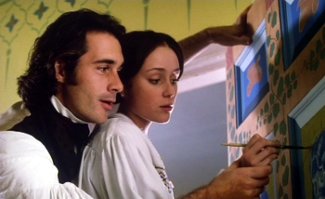
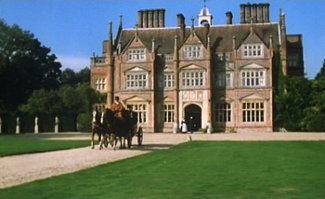
Top: Franklyn Blake (Greg Wise) and Rachel Verinder (Keeley Hawes) spending time together and falling in love. Bottom: Heydon Hall, Norfolk, was used as the family home in The Moonstone.
Sergeant Cuff’s final solution to the crime was based on a rather absurd experiment carried out by the ‘dubious’ assistant doctor Ezra Jennings brought in to replace the family doctor who had to take to his bed after seriously catching cold in the rain on the night of the crime - as it turned out, a most untimely illness! The whole plot of the story actually hangs on the effect of a drug secretly administered to Franklyn by the family doctor, but this is only disclosed to the film-watcher or reader at the very end when the mysterious crime is solved. Wilkie was able to give a very graphic description of the effects of taking the drug ‘laudanum’ (opium taken in alcohol) from his own first-hand experience, as he was prescribed this drug by his own doctor to ease the pain that he suffered from, and to help him cope with the stress of bringing out each episode of the Moonstone on time for publication in Dickens’ journal. In fact, till his death in 1889, Wilkie became increasingly dependent on the drug, very much as did Jennings.
Another interesting feature of The Moonstone is its historical time frame. Although the story is set sometime in the mid eighteen hundreds, it opens with Franklyn Blake awaking from a nightmare in which he experiences the violent theft of a precious Indian diamond, the Moonstone, by a ‘red-coat’, a member of the British East India Company Army following the Siege of Seringapatam in 1799. I have recently discovered and started to read the ‘Sharpe’ series of books by Bernard Cornwell (also a period drama TV series) set in this period and the facts tally well, also borne out by various famous paintings, such as ‘The Last Effort and Fall of Tippoo Sultan’ by Henry Singleton. This fourth and final Anglo-Mysore War between British troops (aided by some Indian allies) and the forces of the Tippoo Sultan, the ruler of the kingdom of Mysore, on the island of Seringapatam (now called Srirangapatna) was a very bloody battle, resulting in victory for the British and the death of the Tippoo. Following the victory, a lot of plundering and looting took place, which the officers tried their best to stop (though many of them seem to have been involved themselves) - finally by introducing hanging for anyone caught doing so. This victory led to British dominance in India for one and a half centuries, which might not have been, as the French were also interested in the territory at the time. However, Nelson’s victory over the French at the Battle of the Nile in 1798 and later the defeat of Napoleon at the battle of Waterloo in 1815 by British-allied troops co-led by Colonel Arthur Wellesley (who, together with Major-General Baird, had commanded the British at Seringepatum), using his title First Duke of Wellington, together effectively ended any chances the French had in India.
Returning to The Moonstone, the scene that Franklyn Blake witnessed in his nightmare could well have been the theft of the precious Indian diamond from the forehead of a sacred statue in the Tippoo’s legendary treasury in his palace on Seringapatam. It was during the siege that the Tippoo was killed in action (though nobody seems to know by whose hand he was slain) and precious gems were looted and stolen. In Wilkie Collins’ story, a family paper written by a cousin of Franklyn’s uncle John Herncastle comes to light (Franklyn has it in his hand and reads it out to the butler Betteredge) in which it is implied, though not proven, that the theft of the Moonstone was carried out by the said John Herncastle, who presumably fought in the British ‘red-coat’ uniform at this battle (showing indeed that the officers were co-culprits of the looting). He is also strongly suspected of having slain the three guarding Indians before helping himself to the spoils of war. On his return to England, his reputation suffered on account of this act, such that his sister, Lady Verinder, refused him access to her house. This snub made him very angry. Supposedly to show his forgiveness for the insult, he left instructions in his will that Franklyn should deliver the diamond to lady Verinder’s daughter Rachel on the occasion of her next birthday following his death, which turned out to be her 18th birthday. He bequeathed it to her probably more in revenge than forgiveness, as the sacred gems of India, including the famous Koh-i-Noor diamond, were believed to bring great misfortune to anyone who unrightfully took possession of them. It seems that this was what he intended for Rachel and the Moonstone certainly appears to have brought with it bad luck – indeed it was stolen on the very day it was given and it caused a string of bad happenings. Franklyn Blake still seems to be having nightmares about it long after the event, when he is presumably happily married to Rachel and all this is over.
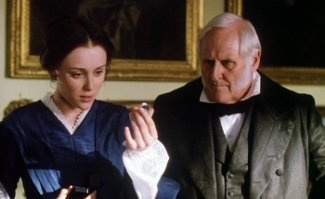
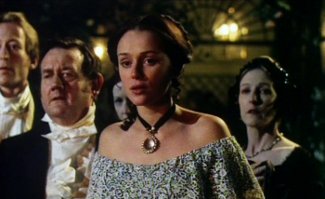
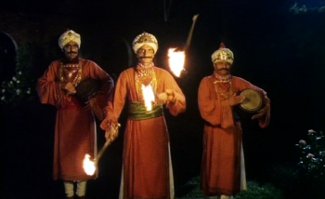
Top: Rachel Verinder (Keeley Hawes) and Gabriel Betteredge (Peter Vaughan) admiring the Moonstone. Middle: Rachel Verinder (Keeley Hawes) wearing the Moonstone on a necklace when the family meet the three Indian jugglers. Bottom: The three Indian jugglers.
The precious diamond referred to in the story is called the Moonstone on account of the fact a certain large yellow-coloured diamond originating from India is rumoured to have increased and decreased in lustre according to the waxing and waning of the moon, and because the earliest references to it described it as being set in the forehead of an Indian moon-god. The deity itself was said to have power over the stone and demanded that it be protected by three Brahmin priests in turn, at all times day and night till the end of time. This tallies nicely with the three Indians in the film, and with Franklyn’s nightmare in which the jewel was snatched from the forehead of the statue and the three Indian guards slain, apparently by John Herncastle. However, from what I have read, the Moonstone appears to have been stolen many times during the wars of the Mogul Empire and finally to have fallen into the hands of the Tippoo Sultan who had it set into the handle of his dagger as he was a great lover of precious stones, and liked to adorn his palace, sword, dagger and clothing with them. The three priests were still meant to keep watch over the stone in its new setting, and ‘woe betide’ anyone who messed with it! In Franklyn’s nightmare at the start of our film The Moonstone, the stone was wrenched from its original setting in the forehead rather than the dagger so I’m a bit confused, but never mind!
There is one last aspect to this period drama which I think is worth mentioning; that is the segregation of class, i.e. the ‘upstairs/downstairs’ aspect. Incidentally, Keeley Hawes (Rachel) again played a very ‘upstairs’ character Lady Agnes Holland in the 2010 episodes of the series Upstairs Downstairs. From such productions we can see clearly that those born with a silver spoon in their mouths were destined for a very different lifestyle from those born without one. We know that going into service was the only option for the children in many families and that the money they brought home with them on their rare days off was essential for the survival of the family. It would seem that the ‘family’ of servants downstairs were often well-fed and well-treated and were reasonably happy with their lot. We see that some servants, especially those from the higher levels of the hierarchy, such as housekeepers and butlers felt such loyalty to their masters and mistresses that they turned down offers of marriage which would entail them leaving the house. Of course, we don’t know how true a picture this is, and certainly some experiences were not at all so good – some would have been positively bad! Anyway, ‘service’, which is an age-old job, was a major source of employment during the 19th and early 20th century, and I should think it compared quite favourably with the terrible working conditions in the mills and mines at the time.
Period dramas such as Downton Abbey show us that some servants, were not satisfied with their station in life; housemaid Gwen passionately wanted to make a career for herself (and Lady Sybil helped her to get a post as a secretary) while Ethel and Thomas were convinced that they could do far better for themselves. Thomas was typical of young men around the time of the First World War, who thought that if they could fight for their country along with the young men from the rich families, things would be different for them after the war. Sadly, for many of these young men, they didn’t live to witness it, but things did change. Also young ladies such as Lady Sybil and Lady Edith discovered that they could find satisfaction in doing useful jobs during the war, and many of them would not wish to return to their lives of enforced leisure, ‘combatting idleness’as Betteredge aptly put it. Speaking for Britain, where I come from and these period dramas are set, alongside equal access to education, opportunities for women in the workplace have improved steadily since then, though can probably never be on a par those open to men; and the class divide has been eroded, but will certainly never disappear. It is not only clearly still there today, but is getting bigger as the top earners reap ridiculous sums of money while those at the bottom struggle; it is maybe just a less open divide than in the days of the Lady, the Master and ‘service’.
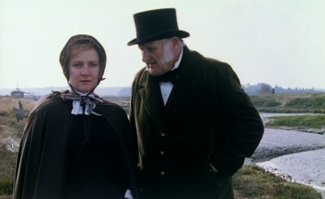
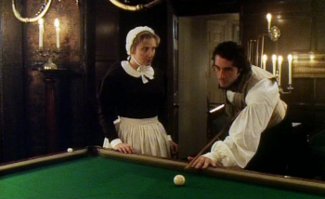
Top: Rosanna (Lesley Sharp) and Gabriel Betteredge (Peter Vaughan). Bottom: Rosanna (Lesley Sharp) and Franklyn Blake (Greg Wise).
Returning to The Moonstone (once again) the maid Rosanna was not happy with her station in life. She fell in love with Franklyn Blake and was desperately unhappy with the way he just looked through her as if she were invisible to him. She attributed this to the class divide, and although there have been famous examples of a lady falling in love with the gardener or the chauffeur, or the chauffeur in love with a lady (such as Tom Branson with Lady Sybil in Downton Abbey), or a master falling for an attractive maid (even if only for his own satisfaction), the divide was generally not to be crossed. It was finally crossed in the case of Jane Eyre and her master Edward Fairfax Rochester, though the gap was smaller in the case of a governess. Poor Rosanna didn’t have looks on her side in addition to the class handicap, and she was driven to taking her life, not without leaving her last testament to be given to her beloved Franklyn and providing a vital clue.
Finally, to conclude, I would say that despite the plot’s being a little absurd seen through our modern sophisticated film-viewing eyes, the 1997 film The Moonstone with its quality acting, beautiful haunting music and atmospheric scenery is well worth watching, and I now feel inspired to start on the book!
2013-01-21
Back to the articles list or the main page.


